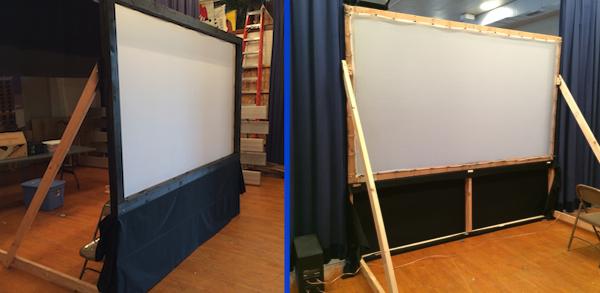When Low-Tech Is Better than Know-Tech

For example, the other day my daughter graduated from 8th grade. In some places, this isn't a big deal. At her school, it is; and, after an elaborate graduation ceremony, it continues with a reception for the families before concluding with a dance/party for the graduates. As tradition would have it, the reception starts with a video presentation comparing pictures of each student as a toddler with one of him or her from this year. The video then continues with a running montage of photos from the class's previous nine years of activities together, and then loops back to the beginning for the duration of the event.
If you're going to be showing a video to 60 kids and who knows how many family members all at one time, you're going to need a big screen—the bigger, the better. Although the school has a couple of portable projectors, mounting one from the high ceiling of the gym wasn't an option. Setting the projector on a table in the middle of the dance floor wasn't a workable idea, either. Since there is an elevated stage in the front of the gym with plenty of room for a rear-projection configuration, though, one of the fathers who got "volunteered" for the task of compiling the video and figuring out how to present it decided that would be the ideal setup. The only trouble was that the school doesn't have a rear-projection screen.
A civil engineer by day and an AV geek by night, my buddy, Steve (a.k.a. the poor dude who got stuck with the job), did what anyone who needs to put a big project together with virtually no budget: he searched the internet for DIY rear-projection screens. It turns out that Elite Screens not only makes a ton of ready-made screens and surfaces, but they also offer a series of DIY front- and rear-projection DIY screen materials. The Wraith Veil rear-projection screens are available in various sizes (96"/ 123"/ 141"/ 171"/ 251") and come with "dynamic rope" and pre-installed attachment grommets that make them about as easy to DIY as DIY gets.
Unfortunately for this project, Elite's Wraith Veil rear-pro screens start at around $100 and go up from there. In the grand scheme of things, that's not a lot of money. In the context of the budget—or lack thereof—that Steve had to work with, it was exorbitantly expensive.
Ah, but the great and good interwebs overfloweth with suggestions and videos of people putting together rear-pro screens (as well as every other kind of screen) for next to nothing in terms of cost. In fact, the most expensive part of many of these projects was the monthly ISP fee. Among other things, DIYers have used bed sheets, drop cloths, and shower curtain liners as screen material. Frames to hold the screen in place range from garage or barn door openings to more elaborate structures made with 2x4s.
Rather than be a total cheapskate, Steve opted for quality and spent four or five bucks more than the cheapest—and thinnest—clear vinyl shower curtain liner he found. (I think his total cost was around $10 for the thicker liner.) Then the engineer in him came out, and he built an impressive wooden frame on which to attach the shower curtain. Since he was on a short deadline, he devised a unique method of adjusting and maintaining the tension on the screen that involved two-inch long pieces of Cat5, a box of small binder clips, and lots of rubber bands. After a quick (and slightly awkward) solo trip to a fabric store, Steve covered the exposed areas of the screen frame with black cloth and used the big stage curtains to block off the rest of the empty stage. The projector and a BD player sat on a table behind the screen, along with a Yamaha AVR Steve used to power the small Bose sub/sat speaker system he'd placed on the front edge of the stage below the screen. (In case you're wondering, acoustically transparent cloth was more expensive than the basic stuff Steve decided to use. So the speakers went in front of the screen's frame rather than behind.)
The picture quality wasn't going to win any Academy Awards, but the image was amazingly bright and sharp—even during the day with all the gym lights on. Most importantly, it was a huge hit with everyone at the graduation reception & party; and it became a topic of more than one conversation amongst the admiring adults who knew a thing or two about big screen TVs and projectors.
Would a 4K projector and an expensive screen been more impressive? From a visual standpoint, absolutely. Would simply aiming the school's data-grade projector at a blank wall and giving everyone a dim, fuzzy look at the past nine years have been less expensive and less work to pull off? You bet. But considering that the whole thing cost less than $30 and maybe half-a-day's work, I doubt there's more than a handful of other setups out there that have returned such a huge level of enjoyment and emotional impact from such a tiny investment of time and money.
I'm as guilty as anyone else (probably more so than most) of continually turning to the highest technology available to solve even the simplest of problems. Steve's DIY MacGyver-style rear-projection setup was a terrific reminder to me that sometimes a low-tech solution is more appropriate (and more fun) than a higher-tech version. Great job, Steve! Who knew a vinyl shower curtain liner and a couple dozen rubber bands would be such a hit?













































